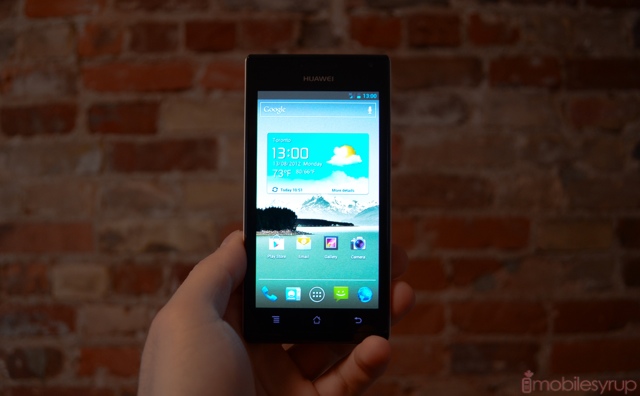
The thin phone craze has reached its zenith, as we’ve come to expect newer phones to shed weight and girth in favour of pocket-friendly (and battery-unfriendly) form factors. Huawei, a relative newcomer to the Canadian market, has launched the Ascend P1 on WIND as a stylish and functional mid-range device. For $399 it has all the right specs to appeal to budget-conscious buyers, but does its slice of stock Android have enough firepower to convince people it’s a better deal than the Galaxy Nexus?
Specs:
– Android 4.0.3 with custom Huawei skin
– 4.3-inch 960×540 Super AMOLED display
– 1.5Ghz TI OMAP 4460 SoC with PowerVR SGX540 GPU
– 1GB RAM, 4GB internal storage (512MB microSD card included in box)
– 8MP camera w/ flash, 1.3MP front-facing camera
– 1670mAh battery
– UMTS 850/900/1700/1900/2100; GSM 850/900/1800/1900
– 110g
– 129 mm x 64 mm x 7.69m
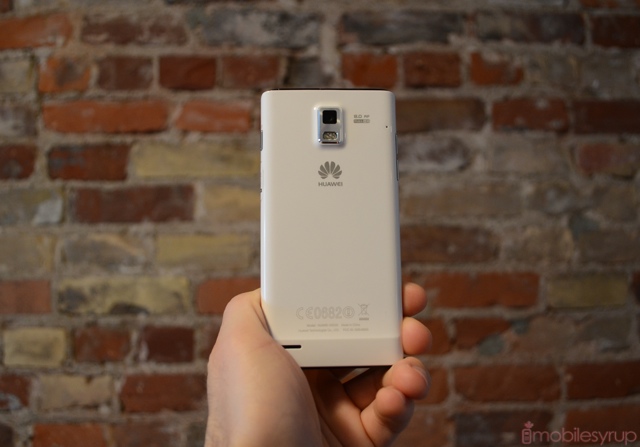
Device & Display
The Ascend P1 is attractive – the black front is curved at the bottom and has limited bezel, with three capacitive buttons below the 4.3-inch qHD screen and a notification light just above it. We’re happy to see Huawei eschew the unnecessary Search button in favour of a three-button layout, but we’d have preferred no capacitive buttons at all. The white plastic casing is glossy and scratch-prone, picking up fingerprints and scuffs too easily. The black-white contrast is elegant, however, and the chrome buttons and camera lens, while plastic, provide the phone with a bit of needed classiness.
The device is slim — 7.69mm at its thinnest point — but there is a sizeable chin at the bottom, and the 8MP camera sticks out of the back like a symmetrical wart. We’re quite happy with the design overall, and its relative small nature makes the Ascend P1 very comfortable to hold in the hand. The 1670mAh battery is non-removable, and you’ll find a full-sized SIM card slot next to the microUSB charging port on top, while a microSD slot shares the right side with the power button.
Huawei’s Ascend P1 doesn’t try anything new when it comes to displays, either, but for the most part the choice works. The 4.3-inch Super AMOLED screen is lush, vivid and bright, with excellent viewing angles, deep blacks and an assured crispness that tries its best to make you forget its PenTile origins. Only when looking closely at the individual pixels can you tell there are slight aberrations on letters and a discomfiting moire pattern on certain graphics and images. It’s not distracting, and can be compared to the HTC One S in acuity. In all, the Ascend offers a very good display for a couple hundred dollars less than the One S, which is a nice compliment. The same can’t be said for the scratch-prone plastic body, but you’re unlikely to be disappointed in the design of the P1.
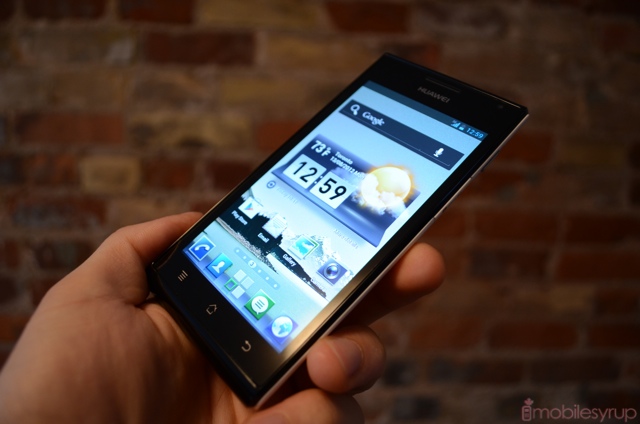
Performance & Software
The Ascend P1 comes with a fairly stock version of Android 4.0.3 — that is, if you use the included 2D Launcher. Huawei also throws in its own garish, sluggish 3D Home launcher that, while it may look good at first, bogs down the device with transition flourishes and unnecessary effects.
If you stick to the 2D Launcher, which is Google’s stock Trebuchet as far as we can tell, you’ll be quite happy with the zippy performance of the Ascend P1. The internal hardware — Texas Instruments’ OMAP 4460 SoC at 1.5Ghz and 1GB RAM — is still pretty fast for a modern smartphone. It’s the same hardware, clocked 300Mhz higher, as the Galaxy Nexus, but the aging PowerVR SGX540 GPU doesn’t have to push as many pixels. This makes it a really able gaming device and, if browsing is your thing, Chrome renders most pages with aplomb.
We found touch performance to be spot-on, and the compact handset felt just right when held in landscape; for that reason, we’d have no problem recommending the Ascend P1 to Android gamers, a growing community indeed. We managed to stream a good amount of 720p and 1080p video and the lower-bitrate stuff played fine but the GPU struggled to decode some of the more difficult stuff.
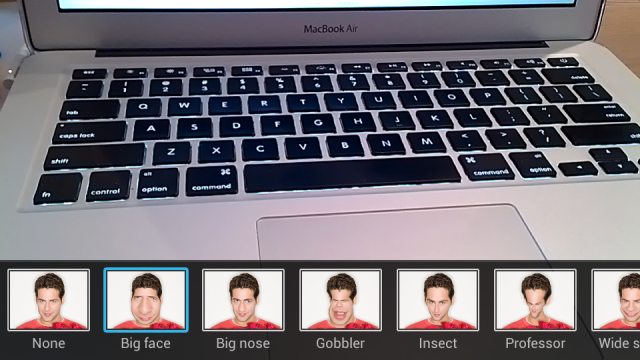
Camera
The Ascend P1 has a decent 8MP camera that won’t turn many heads with its soft photos and overexposed outdoor shots, but for the most part it is a consummate performer in most respects. Huawei has adapted Google’s stock hardware-accelerated real-time morphing abilities, expanding it to include not only face-related processing, but the ability to morph entire scenes a la Paper Camera. While these features won’t be widely used, they’re useful for playful photo sharing.
The Ascend P1 takes photos fairly quickly, though unfortunately it doesn’t have the instant shutter that debuted on the Galaxy Nexus. This is surprising considering the two devices share not only a code base but a hardware base. The f/2.4 lens and 8MP sensor work quite well together, and in the right conditions you’ll get a good shot or two. The device is quite sensitive to shakiness, so a steady hand should solve any bluriness in lower light.
The device can take 1080p video, which is also comparatively soft when compared to newer devices, with a lower bitrate than the Galaxy S III and One X. The sensor also has trouble adjusting to lighting changes, causing a 1-2 second period of over- or under-exposure.

Battery Life
The 1670mAh battery inside the Ascend P1 is non-removable, so it’s a good thing the device isn’t too power hungry. We were able to achieve nearly 18 hours of continuous use from the Ascend on WIND’s network, something that can’t be said of most Android phones today. While we’re aware the relatively small battery was necessary to keep girth to a minimum, we wish Huawei hadn’t gone the “beauty contest” route and instead opted to put a 2000+mAh battery inside the device. We’d much rather have a full day-and-a-half uptime than a wispy smartphone.
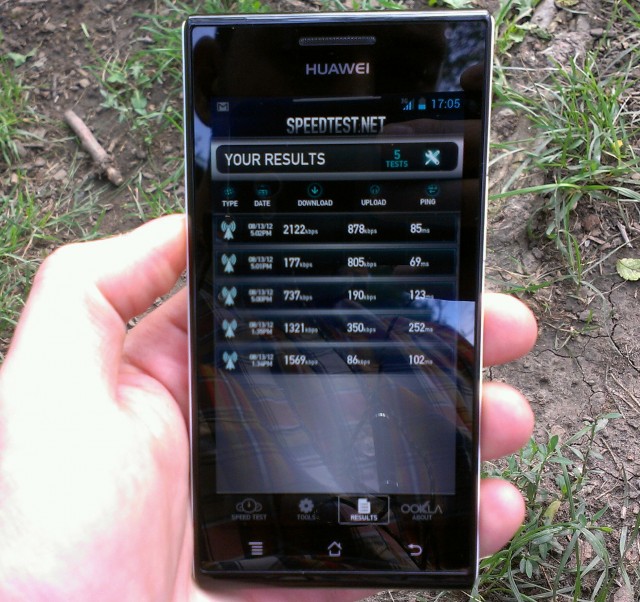
Network Speed & Miscellanous
The Ascend P1 is a pentaband device capable of 21.1Mbps download speeds and 5.76Mbps upload speeds. With the network still in its relative infancy, we were not expecting to hit speeds anywhere near that on the Huawei and we were absolutely right. Download speeds in downtown Toronto averaged 500kbps to 2.2Mbps; upload speeds stayed between 90kbps and 880kbps. In other words, not very fast. The WIND network, while improving throughout the country, is a still a good deal slower than even Rogers/TELUS/Bell’s 3G network.
The device does come with a microSD card slot, but a meagre 512MB card is bundled. Along with an underserving 4GB of internal storage, you’re likely going to want to invest in a 8-32GB microSD card.
We noticed that the P1 sounds great over WIND’s network, and the back speaker is fairly loud and clip-free for a tiny mono crevice.

Conclusions
The Huawei Ascend P1 does everything mostly right, and its weaknesses are built into the price. A decent performer with a mostly-stock version of Ice Cream Sandwich, the $399 handset is one of the fastest, thinnest, and most attractive mid-range devices on the market.
While WIND still sells the Galaxy Nexus for $499, there’s a chance they will lower it to the $299 mark set by Mobilicity in the coming weeks. If they do so, the Ascend P1 becomes much harder to recommend despite its all-round goodness. Still, the Ascend P1 sits nicely below the Galaxy Nexus and Galaxy S III in WIND’s back-to-school roster and is a great device for someone looking to simplify, downsize or merely save a few bucks.
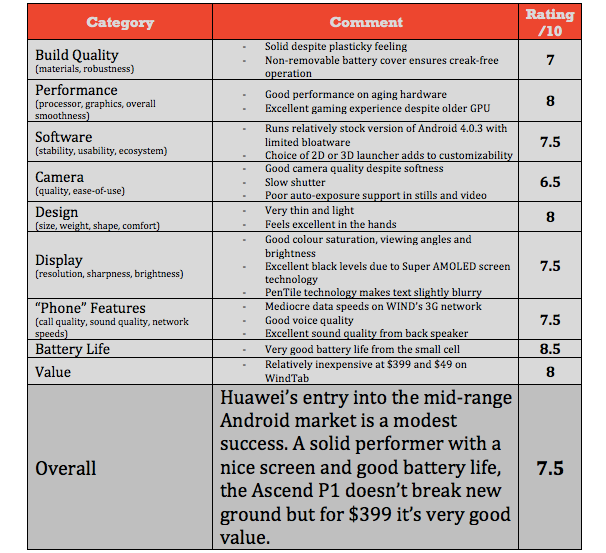
MobileSyrup may earn a commission from purchases made via our links, which helps fund the journalism we provide free on our website. These links do not influence our editorial content. Support us here.




